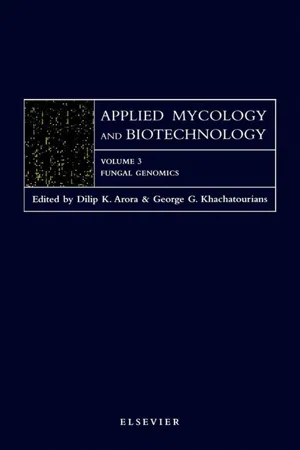1 INTRODUCTION
With the advent of the genomics era during the last decade, we have witnessed a revolution in our understanding of biological processes. Since 1995, the genomes, or genetic make-up, of dozens of bacteria and a few model eukaryotes have been completely sequenced. With the exception of Saccharomyces cerevisiae, fungal genomics was not a priority in these early efforts. Despite the slow start, however, fungal genomics has gained significant momentum in recent years. Genomic sequencing efforts now are underway on dozens of fungi, including species that are of fundamental biological interest, species that are important to industry and agriculture, and species that cause opportunistic human infections (Bennett and Arnold 2001). The Kingdom Mycota contains a diverse array of multicellular microorganisms, or fungi. It is estimated that there are over one million species of fungi and that a large proportion of species have yet to be identified (Hawksworth, 1991). The interactions of fungi with other organisms have played a vital role in the evolution of microorganisms, plants, and animals.
Fungi are adapted to acquire nutrient molecules from their environments as decomposers (saprophytes) or parasites, or both. Fungi are also very important to global ecosystems (Price et al., 2001; Souciet et al., 2000). Many fungi are beneficial and are used as sources of food (e.g. mushrooms), chemicals (e.g. gluconic acid, citric acid), and pharmaceuticals (e.g. penicillin). Aspergillus oryzae and other food grade fungi are used for large-scale fermentation for industrial enzymes (e.g. amylases, pectinases and proteases), and A. sojae for soy sauce fermentation. Common yeast, S. cerevisiae, is used in brewing and in baking. Other fungi are harmful because they are pathogens of plants, animals, and humans, or produce metabolites that are toxic to plants (phytotoxins) or animals (mycotoxins) (Souciet et al., 2000; Orke et al., 1994; Bhatnagar et al., 2002; Richard and Payne, 2002). Because of the significant impact of fungi on the world economy and on human health, tremendous efforts have been made to exploit the benefits of fungi and to reduce their potential harmful effects (for reviews see Bennett, 1998; as well as http://www.cbs.know.nl/search_fdb.html).
The rapid development of high-throughput DNA sequencing technology has provided a powerful tool for genetic research, from single gene cloning to whole genome sequencing. With the application of genomics and, in particular, of expressed sequence tag (EST) and microarray technologies, we are able to study fungi on the molecular genetic level far more rapidly than ever could be achieved with traditional and biochemical genetic approaches. Genomics has accelerated development of effective strategies to control opportunistic fungal infections of humans, and to maximize industrial use of fungi and reduce mycotoxin contamination of food and feed, resulting in a sustainable, nutritious, safe, and economical food supply for the ever-increasing world population. This article is intended to provide the reader with some basic concepts of genomics, followed by an overview of the history of fungal genetics and genomics. Excellent recent reviews provide additional information on these topics (Bennett and Arnold, 2001; Fakhoury and Payne, 2003).
2 GENOMICS
The concept of the genome originated in the field of cell cytology, in reference to a complete set of chromosomes in a single cell of an organism (Sybenga, 1972). The modem concept of the genome, however, refers to all of the DNA sequence information in a single cell, often designated as nucleotides or mega base pairs (Mb). Genomics is the study of the genome of an organism, and includes the sequencing and annotation of the entire genome. The term GENOMICS, coined in 1986 by Thomas Roderick to provide a name for a new journal, included mapping, sequencing, and analysis of genomes (Hieter and Boguski, 1997). In a broader sense, however, sequencing and annotation are only a part of genomics, which can be divided into three major components: structural, comparative, and functional. Structural genomics is the physical sequencing and annotation of all of the genetic material of an organism. Structural genomics has been defined as the “initial phase of genomic analysis: with a clear end point that results in the construction of high resolution genetic, physical and transcript maps of an organism” (Hieter and Boguski, 1997). Comparative or evolutionary genomics is the comparison of DNA sequences of related organisms through advanced computer technologies, or bioinformatics. Functional genomics is the identification of the functions of each coding sequence through analysis of gene expressi...
